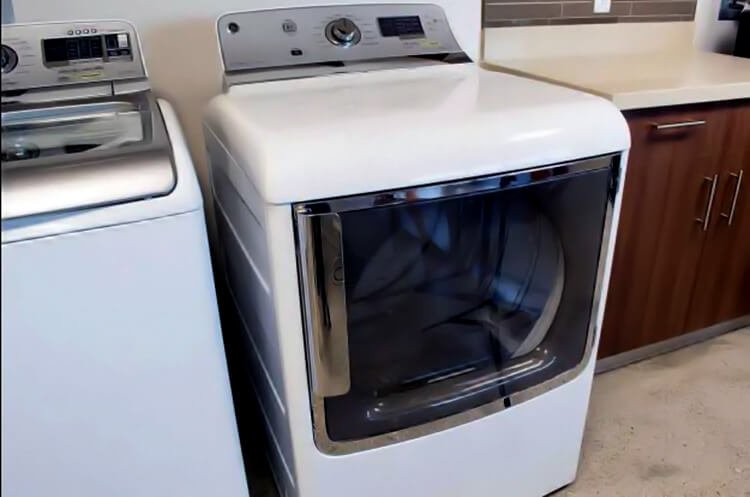GE dryer troubleshooting can be done by checking the power supply and making sure it’s properly connected. If the power is not an issue, check the door switch, thermal fuse, and start switch.
A broken dryer can be frustrating, especially if it happens in the middle of doing laundry. Is your GE dryer not working and you don’t know what to do? Before calling a professional for help, try troubleshooting the problem yourself.
Check the power supply first to make sure it’s properly connected and turned on. If that’s not the issue, there could be a problem with the door switch, thermal fuse, or start switch. This article will provide a comprehensive guide on GE dryer troubleshooting so that you can diagnose and fix the issue without spending too much on repairs.

GE Dryer Will Not Start
Has your GE dryer refused to start? It is frustrating when you load your dryer only to realize it won’t start. Here are some possible reasons your GE dryer may not start:
The Control Panel Is Not Responsive
If your dryer’s control panel won’t respond when you press any button or it’s not lighting up, examine the following potential causes:
- The dryer’s control board could be burnt out or damaged.
- Check the power source and ensure it is properly connected.
- If there is still no response, replace the control panel.
The Power Cord Is Damaged
If the dryer is not turning on at all, check its power cable for burns, kinks, or other damages. If the cord is damaged, replace it with a new one.
The Door Switch Is Broken
If the dryer drum light turns on when you open the door but the dryer won’t start when you press start, the door switch might be the problem.
- Ensure the door is closed completely.
- If that doesn’t work, test the door switch and replace it if necessary.
The Thermal Fuse Is Blown
Ge dryers have a thermal fuse, which blows when the dryer overheats. If the thermal fuse is blown, the dryer won’t start. Follow these steps:
- Disconnect the dryer from the power source.
- Test the thermal fuse using a multimeter.
- Replace the thermal fuse if it’s blown.
The Timer Is Malfunctioning
The GE dryer’s timer controls the drying time. If the dryer won’t start, the timer could be the problem. If so:
- Test the timer using a multimeter.
- Replace the timer if it’s not working correctly.
By following these steps, you can identify the problem when your GE dryer refuses to start and fix it appropriately.
GE Dryer Is Not Heating
There’s nothing more frustrating than a dryer that won’t heat up, especially when you have laundry to do. Fortunately, many common causes of this problem are easy to fix. Here are some of the most typical reasons why your dryer might not be heating up.
The Dryer Vent Is Clogged
- One of the primary reasons for a dryer to not heat up is a clogged vent.
- When the lint trap isn’t cleaned properly, debris can accumulate over time, and restrict the airflow.
- It causes the dryer to work harder, which eventually leads to overheating, and then shuts off the heating element.
- Regular cleaning of the lint trap and the dryer vent is essential to prevent clogging and proper airflow.
The Thermal Cutoff Switch Is Faulty
- The thermal cutoff switch measures the temperature inside the dryer and turns off the heating element when it gets too hot.
- A faulty thermal cutoff switch can cause the dryer to overheat or not heat up at all.
- You can test it with a multimeter or have an expert do it for you.
- Replacing a faulty thermal switch is essential, and it should always be done by a qualified professional.
The Heating Element Is Broken
- A broken heating element is another possible reason for a dryer not heating up.
- The heating element is a component that warms up the air before it enters the dryer drum. It can burn out due to overuse or old age.
- A visual inspection of the heating element can tell you if it’s broken or not.
- Replacement or repair of the heating element should be done by a competent technician.
The Cycling Thermostat Is Malfunctioning
- The cycling thermostat monitors the temperature of the air passing through the dryer drum.
- If it malfunctions, the dryer doesn’t heat up at all or overheats.
- A faulty cycling thermostat should be replaced immediately by a trained professional.
The Temperature Sensor Is Faulty
- The temperature sensor or thermistor monitors the air temperature in the dryer drum and regulates the temperature of the heating element.
- If it malfunctions, it can lead to a dryer that doesn’t heat up or overheats.
- A defective temperature sensor requires replacement by a knowledgeable technician.
By following these tips, you can troubleshoot and solve problems causing your dryer to not heat up. It’s essential to keep your dryer in good working condition to extend its life, save energy, and avoid costly repairs.
GE Dryer Is Making Strange Noises
No one wants their dryer to make strange noises. It can be alarming and a sign that something is wrong with your machine. Here are some troubleshooting steps to take if your dryer is making strange noises.
The Dryer Is Vibrating Excessively
- Check if your dryer is level. If it’s not, adjust the legs until it’s balanced.
- Make sure your dryer is not overloaded, which can lead to vibration.
- Check if any of the parts, such as the drum or motor, are loose or damaged.
The Drum Slide, Glide, Or Bearing Is Worn
- Turn off the dryer and unplug it, then check for any signs of wear on the drum slides, glides, or bearings.
- Replace any worn or damaged parts following the manufacturer’s instructions.
The Idler Pulley Or Drive Belt Is Damaged
- Inspect the idler pulley and drive belt for any signs of damage or wear.
- Replace any damaged or worn parts promptly.
The Blower Wheel Is Damaged Or Clogged
- Turn off the dryer and unplug it, then check for any debris clogging the blower wheel.
- If there is none, inspect the blower wheel for any signs of damage.
- Replace any damaged parts following the manufacturer’s instructions.
The Motor Itself Is Faulty
- If the motor is the source of the strange noise, then it might be time for a replacement.
- Contact a professional appliance repair technician to diagnose and repair the issue.
Identifying the source of the strange noise in your dryer may require some troubleshooting steps. By following the above guidelines, you can make your dryer function properly without any unusual noises.
Frequently Asked Questions
How Do I Reset My GE Dryer?
To reset your GE dryer, unplug it for one minute, then plug it back in and start a new cycle.
Why Isn’t My GE Dryer Turning On?
If your GE dryer doesn’t turn on, check the circuit breaker, the power cord, and the door switch.
How Do I Clean The Lint Filter On My GE Dryer?
To clean the lint filter on your GE dryer, slide the filter out and remove any lint buildup. Rinse in soapy water and dry thoroughly before use.
Why Isn’t My GE Dryer Heating Up?
If your GE dryer isn’t heating up, check the thermostat, the heating element, and the power source.
How Do I Troubleshoot A Noisy GE Dryer?
To troubleshoot a noisy GE dryer, check for loose parts, worn belts, or damaged rollers. Tighten or replace as needed.
Conclusion
GE dryer troubleshooting can save you time and money by identifying and solving common issues on your own. In this article, we have discussed the most common glitches, including the dryer not starting, the drum not spinning, and the dryer making strange noises.
Following the steps outlined in this guide can help you fix the issue without calling a repairman. It is essential to ensure that the dryer is unplugged before attempting any repairs for safety purposes. By performing regular maintenance, such as changing the lint filter and cleaning the vent, you can prevent future problems from arising.
Remember, if the issue persists, it may require professional assistance to fix. Hopefully, this guide has provided you the tools and knowledge necessary to troubleshoot common GE dryer issues effectively.
Read More: Maytag Dryer Troubleshooting

